Introducing the RAADS-R Test
The RAADS-R (Ritvo Autism Asperger Diagnostic Scale-Revised) is an essential self-report questionnaire designed to identify autism spectrum disorder (ASD) traits in adults aged 18 and older. As autism diagnosis in adulthood becomes increasingly recognized, validated tools like the RAADS-R are critical for clinicians to assess individuals who may have been undiagnosed in childhood. This article explores the test's structure, use, and role within broader autism diagnostic and therapeutic contexts.
What is the RAADS-R Test?
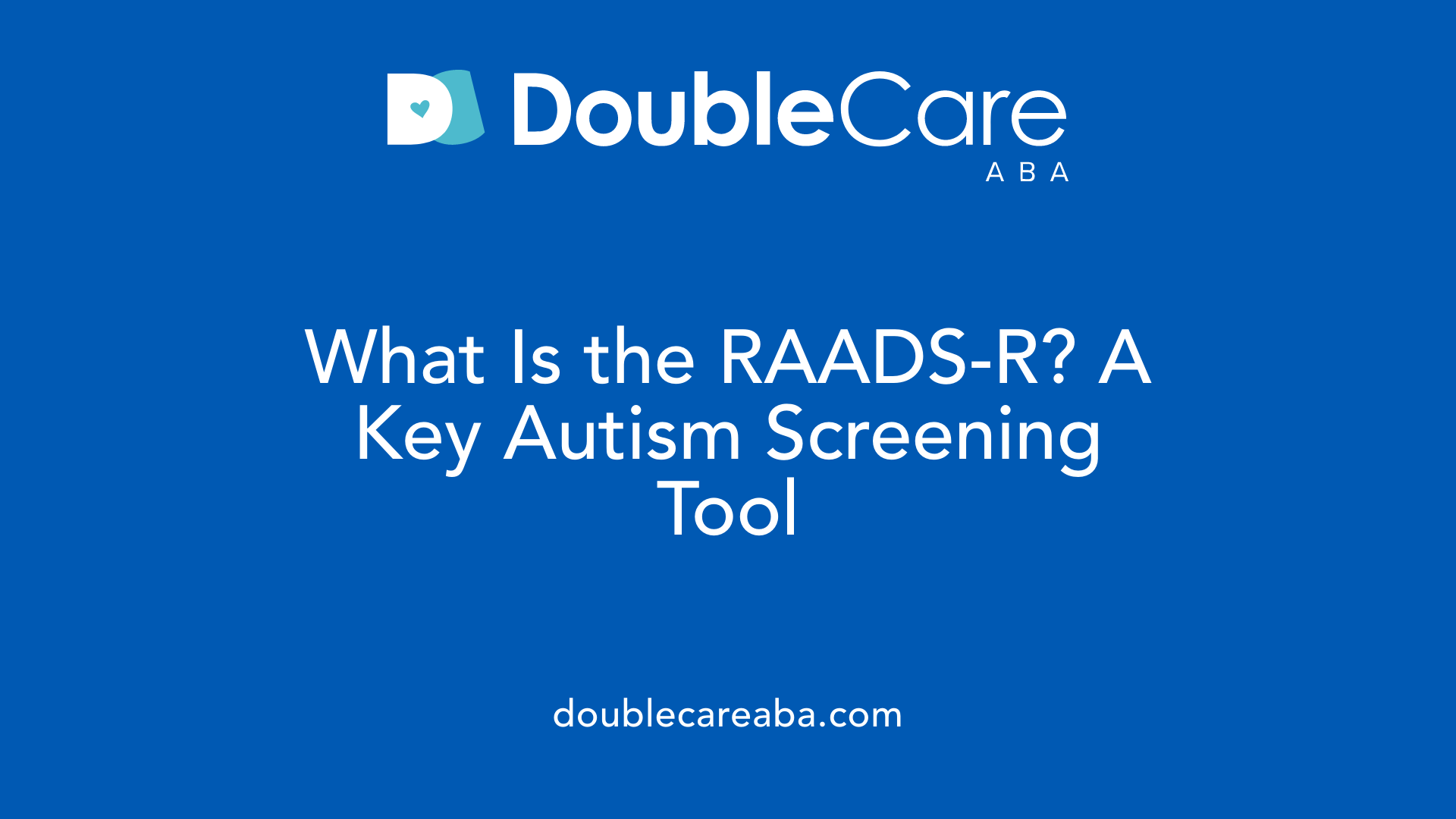
Definition and purpose of RAADS-R
The Ritvo Autism Asperger Diagnostic Scale-Revised (RAADS-R) is a self-report questionnaire designed specifically to identify traits associated with autism spectrum disorder (ASD) in adults. It consists of 80 items that explore symptoms across four primary domains: social relatedness, language, sensory-motor behaviors, and circumscribed interests. This tool helps clinicians evaluate both current and historical experiences by asking respondents to rate behaviors on a four-point Likert scale, thereby capturing lifelong patterns that may indicate autism.
Target population
The RAADS-R is intended for adults aged 18 and over, particularly those who may have been undiagnosed or misdiagnosed in childhood. This age focus addresses the important need for validated assessments tailored to adult populations, as autism presentation in adults can often be subtle or masked.
Role in autism identification
While the RAADS-R itself is not a standalone diagnostic tool, it plays a crucial role in supporting clinicians during the autism diagnostic process. Its total score ranges from 0 to 240, with scores at or above 65 suggesting the presence of significant autism traits. The test’s revised thresholds aid in clinical decision-making: scores below 106 indicate autism is unlikely, 106 to 139 suggest traits consistent with autism warranting further evaluation, and 140 or higher strongly support presence of autism traits. This layered scoring helps reduce false positives and guide referrals for comprehensive assessments.
Additionally, psychometric studies confirm that the RAADS-R is a reliable, unidimensional measure with high internal consistency, making it widely adopted by professionals globally in both clinical and applied behavior analysis settings. It offers detailed profiles through subscales, allowing nuanced understanding of a person's autism-related behaviors and thereby aiding personalized intervention planning.
Core Symptom Domains Assessed by the RAADS-R
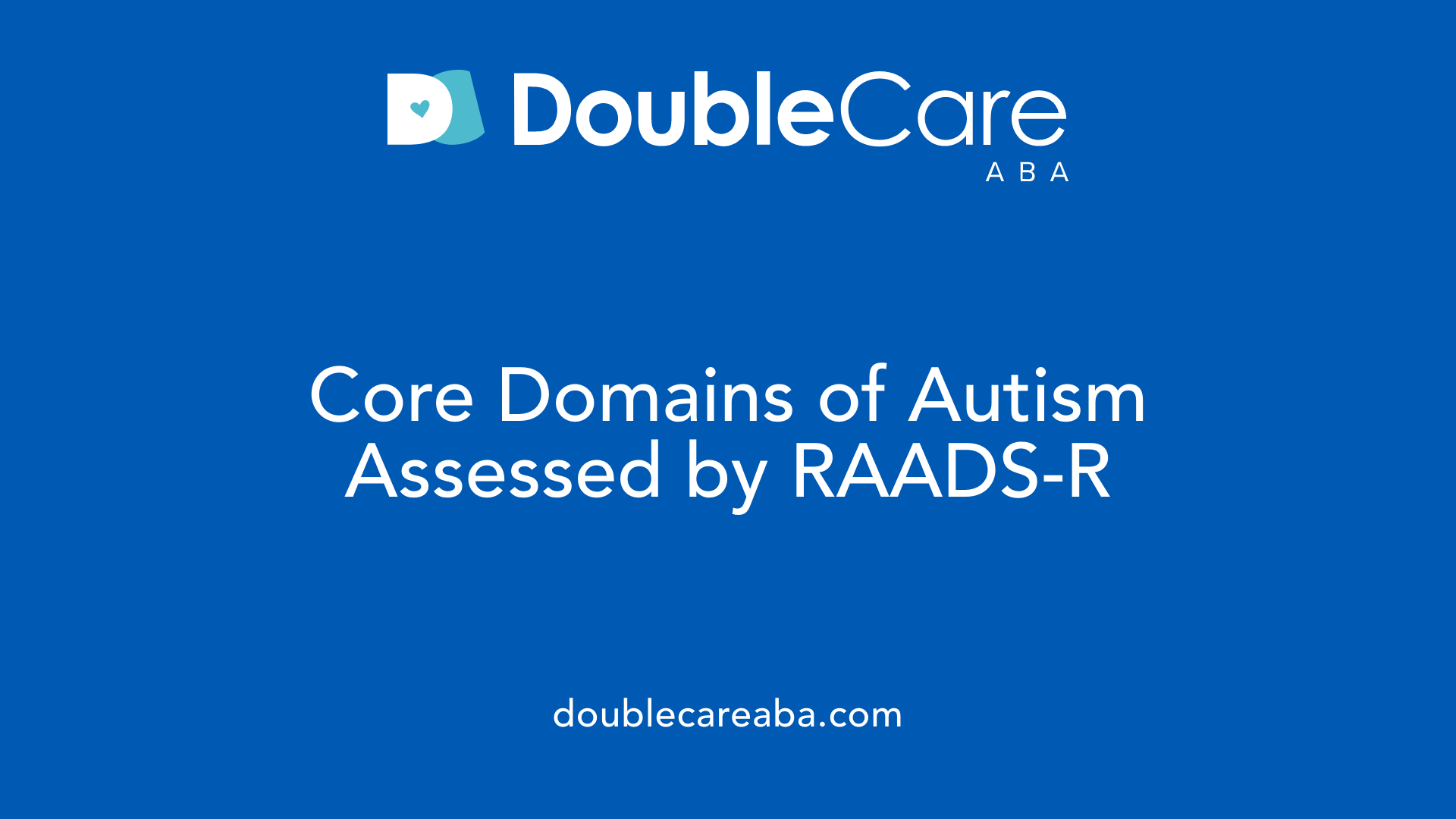
Which symptom domains does the RAADS-R evaluate?
The RAADS-R evaluates four core symptom domains that are central to autism spectrum disorder (ASD). These domains include social relatedness, circumscribed interests, language, and sensory-motor behaviors.
Each domain reflects essential areas where individuals with autism often experience challenges or display distinct patterns. Social relatedness covers difficulties in social communication and connection with others. Circumscribed interests refer to intense, focused interests that are more limited in scope compared to typical interests. Language captures both the use and comprehension of verbal and nonverbal communication. Lastly, sensory-motor behaviors involve unusual responses to sensory stimuli or differences in motor function.
Considering these four domains enables the RAADS-R to assess a broad range of autism-related traits, which are essential for understanding the condition in adults. Focusing on these areas helps clinicians identify both lifelong and current patterns of behaviors that characterize ASD. This thorough assessment is especially important because autism in adults may present differently than in children, making these symptom areas vital for accurate evaluation.
By evaluating these four distinct but interrelated domains, the RAADS-R provides a comprehensive profile of autistic traits, supporting clinicians in recognizing adults who may have been undiagnosed in childhood or who have subtle autism features. Understanding these key areas aligns with contemporary clinical perspectives on autism and enhances diagnostic precision.
Capturing Lifelong and Current Behavioral Patterns

How does the RAADS-R assess behaviors to differentiate developmental history?
The RAADS-R is carefully designed to capture a comprehensive behavioral profile by evaluating both past and present experiences. Each of the 80 items in the questionnaire includes response options that specifically distinguish between current symptoms and historical behaviors. This unique format allows respondents to provide detailed information about their experiences across different life stages.
This approach is significant because autism spectrum disorder (ASD) is characterized by developmental patterns that often emerge in early life. By gathering data on lifelong traits, the RAADS-R helps clinicians identify patterns consistent with ASD that have persisted since childhood, rather than traits that might have developed solely in adulthood.
Recognizing lifelong patterns versus adult-onset behaviors is crucial for accurate diagnosis. Many adults undergoing evaluation for autism may have subtle or previously unrecognized symptoms from childhood. The RAADS-R’s method of differentiating these behaviors supports a clearer understanding of an individual’s developmental history, avoiding misclassification based on only current observations.
In summary, the RAADS-R’s inclusion of both historical and current behavioral data supports clinicians in making more informed decisions by highlighting persistent autism-related traits, thus enhancing the accuracy of assessments for adult populations.
Scoring and Thresholds for Clinical Interpretation
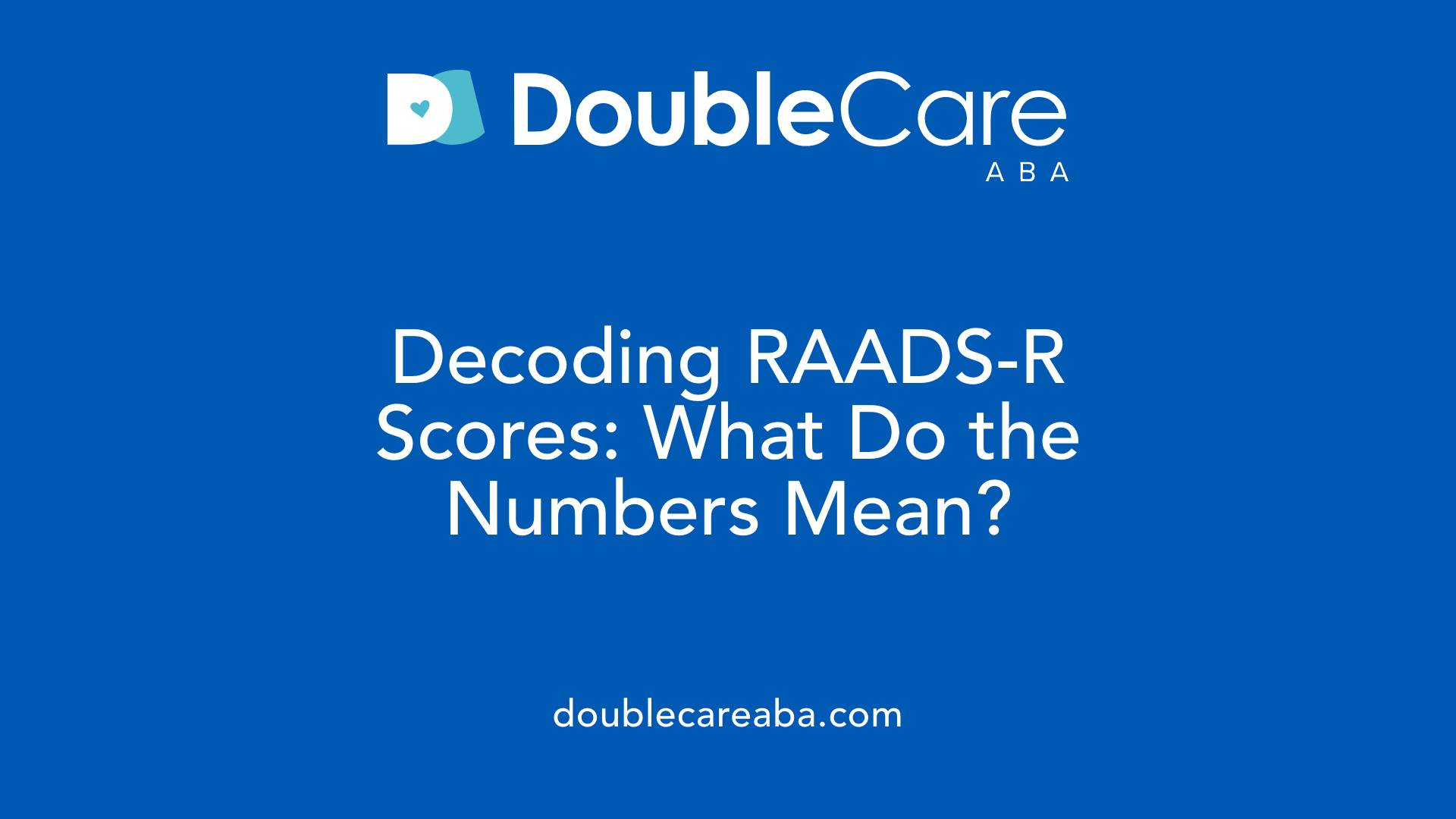
What do the RAADS-R scores mean?
The RAADS-R total score ranges from 0 to 240, with higher scores indicating a greater likelihood of autism spectrum disorder (ASD).
Scores are interpreted using updated thresholds that enhance clinical utility and specificity. A score less than 106 suggests that autism is unlikely, helping to rule out ASD in adults during screening.
Scores between 106 and 139 indicate traits consistent with autism. This range signals the need for clinicians to consider further comprehensive diagnostic assessment to clarify the presence of autism-related characteristics.
Scores of 140 or more strongly indicate pronounced autism traits, providing clear guidance for clinical decision-making toward an ASD diagnosis.
Significance of Updated Thresholds
Recent psychometric analyses improved the RAADS-R’s scoring cutoffs to reduce false positives in clinical populations. The two critical cutoff points — 106 and 140 — differentiate between unlikely autism, consistent traits, and pronounced traits. This nuanced scoring supports clinicians in identifying subtle presentations and ensuring appropriate referrals.
Clinical Decision-Making Guidance
Clinicians use the RAADS-R total score alongside behavioral subscale profiles and developmental history. The thresholds guide the next steps in assessment rather than serve as definitive diagnosis. A score in the 106–139 range typically prompts detailed evaluation through interviews, collateral information, and additional standardized tools. Scores above 140 strengthen the evidence for autism and may prioritize intervention planning.
Overall, the RAADS-R score interpretation equips healthcare providers with a reliable, validated framework for screening adult autism, ensuring comprehensive and accurate clinical understanding.
Reliability and Psychometric Properties of the RAADS-R
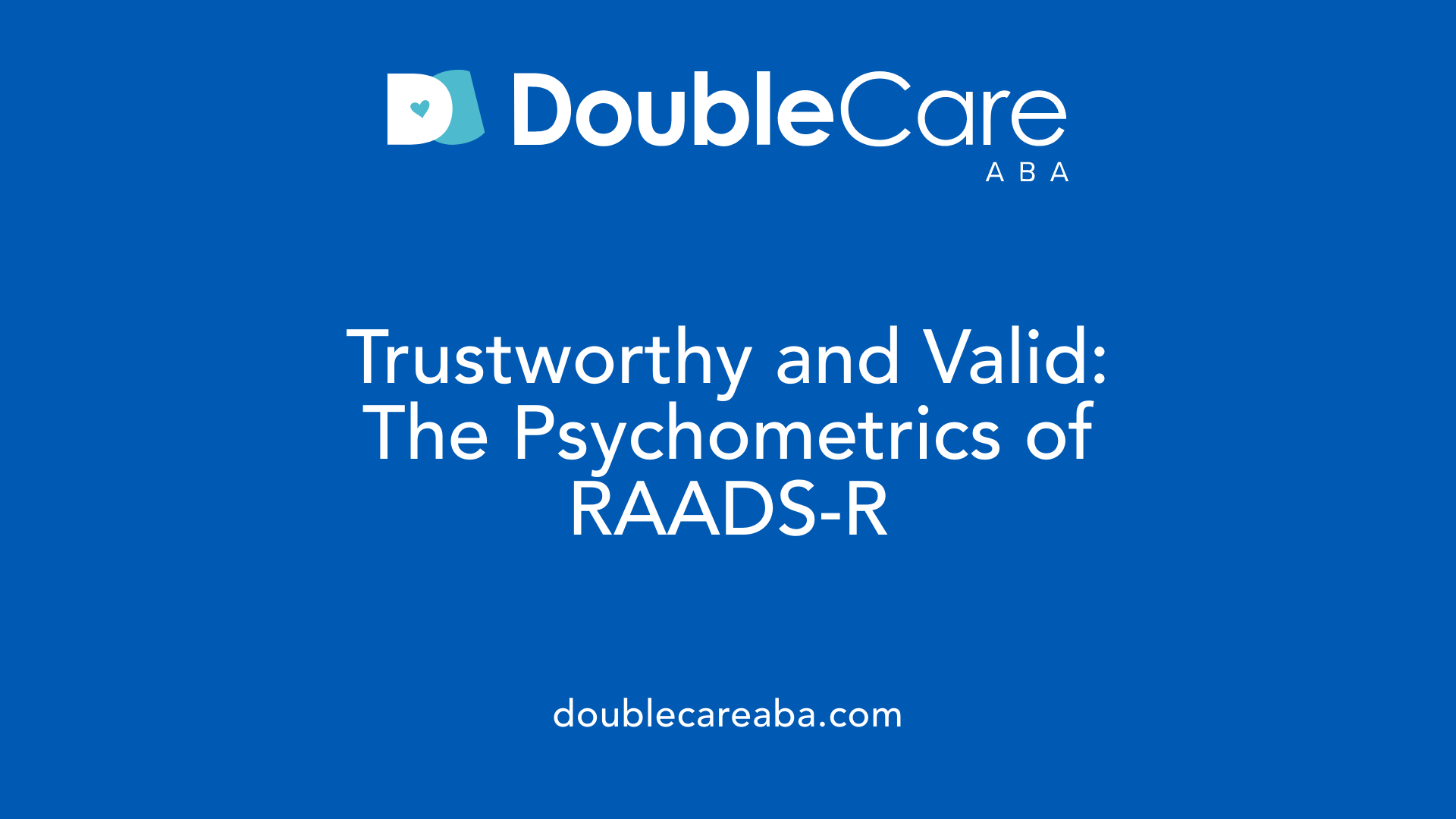
How reliable is the RAADS-R as a measure of autism?
The Ritvo Autism Asperger Diagnostic Scale-Revised (RAADS-R) has undergone recent psychometric re-evaluation, confirming its function as a unidimensional measurement tool. This means that despite assessing multiple domains such as language, social relatedness, sensory-motor behaviors, and circumscribed interests, the RAADS-R effectively captures a single overarching construct related to autism traits.
One of the standout findings in the validation process is the exceptionally high internal consistency of the RAADS-R, demonstrated by a Cronbach’s alpha coefficient of 0.97. This level of reliability indicates that the 80-item self-report questionnaire consistently measures autism-related traits across diverse clinical populations.
High internal consistency is crucial for clinical tools, ensuring that responses on various items are well correlated and contribute meaningfully to the overall score. This reliable performance supports clinicians in confidently using the RAADS-R for screening adults, especially those who may have been undiagnosed during childhood.
The RAADS-R’s psychometric strengths bolster its reputation as a trusted aid in autism assessment—providing dependable data that complements comprehensive diagnostic evaluations. Thanks to its reliability, the RAADS-R is widely adopted in clinical and research settings worldwide, facilitating early identification and better characterization of adult autism spectrum disorder.
Subscale Use and Clinical Characterization
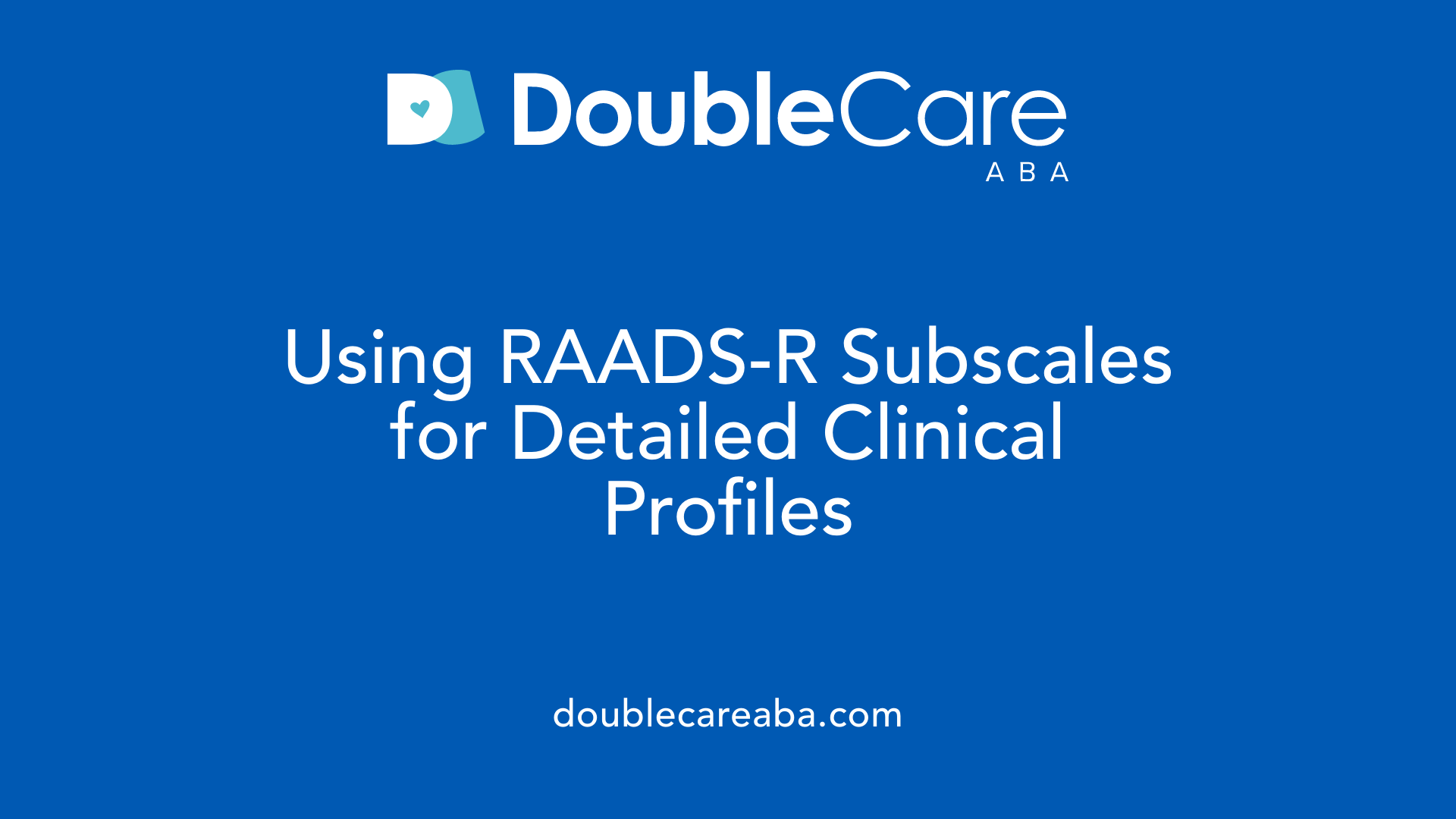
How do RAADS-R subscales assist clinicians?
The RAADS-R assessment is structured around four subscales that collectively cover distinct domains commonly affected by autism spectrum disorder. These include language, social relatedness, sensory-motor functions, and circumscribed interests. Each subscale delves into specific behavioral traits, enabling clinicians to construct nuanced behavioral profiles for individuals undergoing assessment.
Despite the RAADS-R functioning as a unidimensional measure based on psychometric analyses, these subscale profiles hold considerable clinical value. They allow professionals to identify which particular areas contribute most to an individual's overall score. For example, heightened scores in the sensory-motor subscale may indicate notable sensory sensitivities or motor difficulties, while elevations in circumscribed interests reflect focused and restricted patterns of behavior or interests.
This layered understanding supports clinical characterization by revealing an individual's unique autism trait profile rather than relying solely on a single composite score. It can guide tailored diagnostic considerations and inform intervention strategies by highlighting behavioral domains that warrant focused attention.
In summary, the RAADS-R subscales enhance the clinical utility of the questionnaire by providing detailed insights into core ASD symptom domains. This helps clinicians move beyond a simplistic diagnostic threshold to robustly interpret the complex presentation of autism traits in adults.
Role of RAADS-R Within a Comprehensive Autism Diagnostic Process
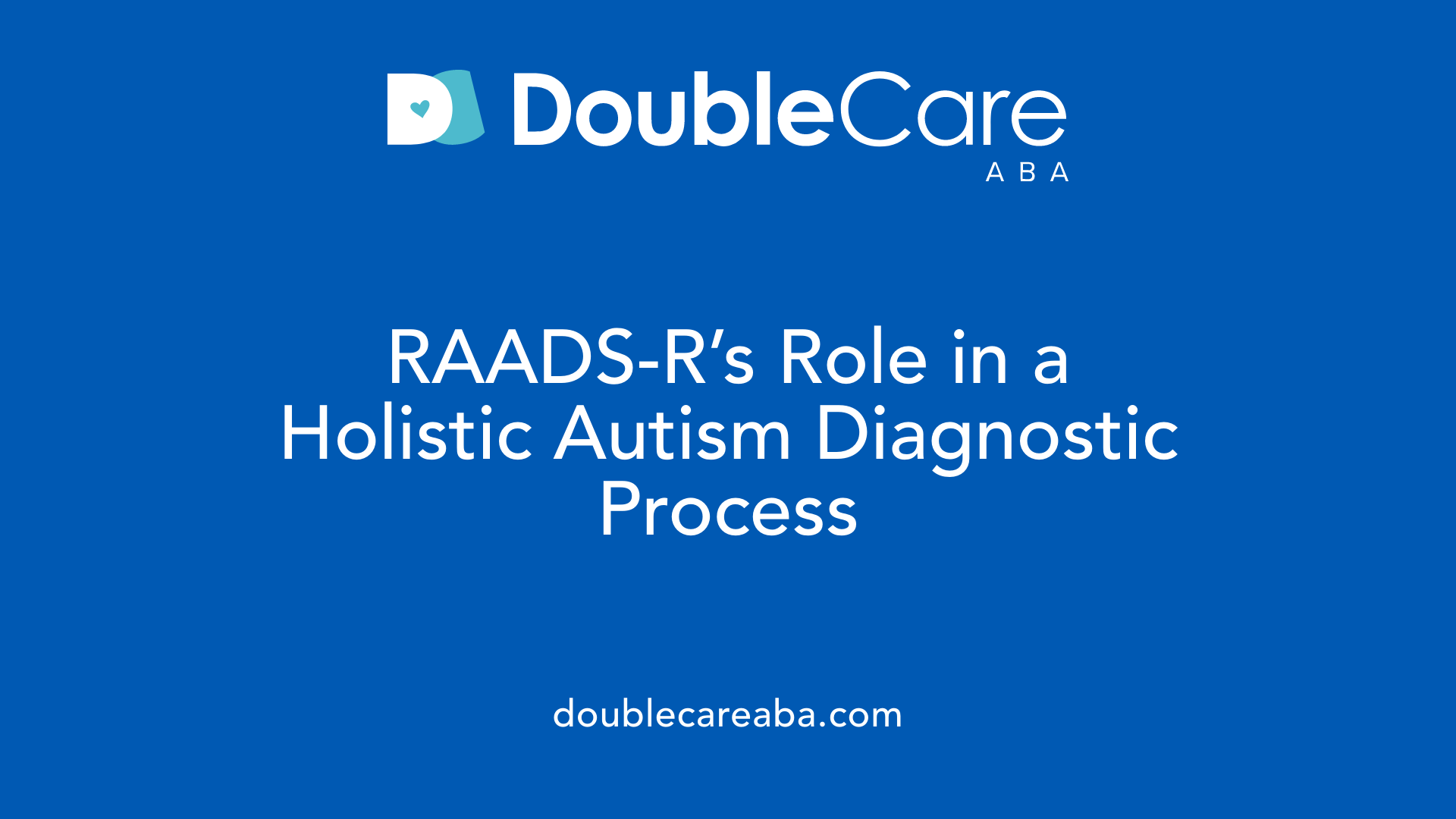
Is the RAADS-R a standalone diagnostic tool?
No, the RAADS-R is not used as a standalone diagnostic test for autism spectrum disorder (ASD). It is a self-report questionnaire designed to help clinicians identify autism-related traits in adults, particularly those who may have subtle or previously undiagnosed presentations. The tool provides valuable clinical information about an individual’s behaviors and symptoms but does not replace the comprehensive evaluation necessary for a formal diagnosis.
How does the RAADS-R integrate with other diagnostic approaches?
The RAADS-R is typically used alongside other assessment methods such as clinical interviews, gathering collateral information, additional standardized measures, and thorough differential diagnosis. This integrative approach allows clinicians to consider multiple perspectives and data sources. For example, while the RAADS-R captures current and historical behaviors across four domains—language, social relatedness, sensory-motor functions, and circumscribed interests—clinical interviews provide depth and nuance to these findings.
Why is a comprehensive approach important?
Autism spectrum disorder presents heterogeneously, with factors like gender, cultural background, and co-occurring conditions influencing the clinical picture. Masking strategies and developmental history also impact symptom expression and assessment results. By combining the RAADS-R with detailed clinical evaluations, practitioners increase diagnostic accuracy and ensure that intervention plans are tailored effectively.
In summary, the RAADS-R serves as a reliable screening and supportive tool that contributes important information during the diagnostic process. Its results guide decisions about the need for further assessment but must be interpreted within the broader context of a multidisciplinary diagnostic approach.
Administration and Scoring Methodology
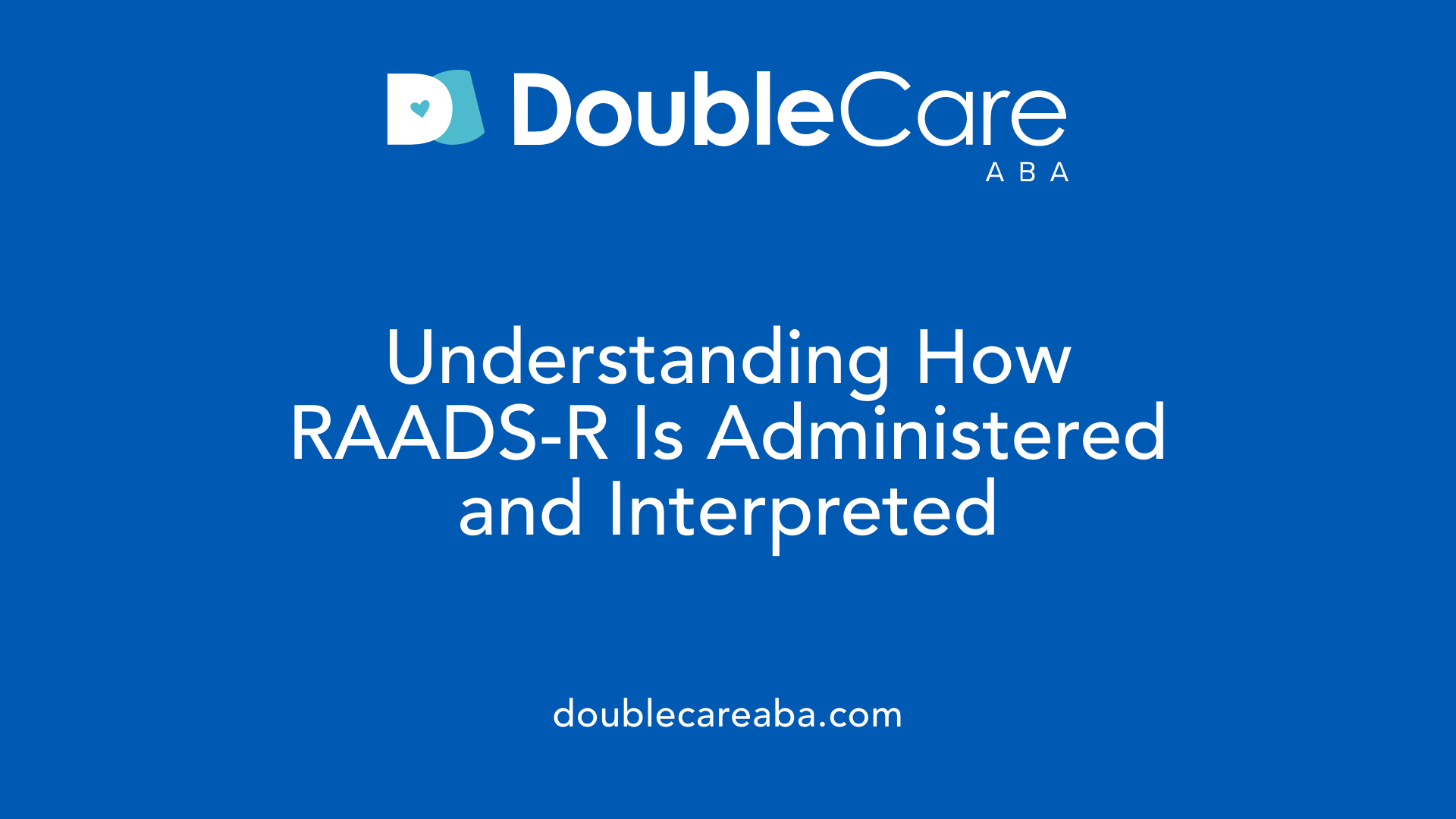
How is the RAADS-R test administered and scored?
The RAADS-R is a self-report questionnaire consisting of 80 items that are rated on a four-point Likert scale. This format enables individuals to indicate their experiences and symptoms with varying degrees of agreement or frequency.
Uniquely, the RAADS-R captures both current and historical behaviors, providing insight into how traits may have manifested throughout a person's lifetime. This dual temporal focus is essential in discerning lifelong autism-related patterns from those that might have emerged more recently.
Each response option is carefully structured to reflect nuances in behavior—for example, distinguishing whether a symptom was present in childhood, continues currently, or both. This granularity aids clinicians in building a detailed profile of autism-related traits.
The total score ranges from 0 to 240, with higher scores indicating a greater likelihood of autism spectrum disorder traits. A score below 106 suggests autism is unlikely, 106 to 139 signals traits consistent with autism and the need for further diagnostic assessment, and 140 or above strongly indicates autism traits. These revised thresholds improve screening specificity and reduce false positives.
Through this comprehensive scoring methodology, the RAADS-R offers clinicians a standardized yet nuanced tool to assess adult autism traits effectively.
Clinical and Demographic Considerations for Interpreting RAADS-R Results
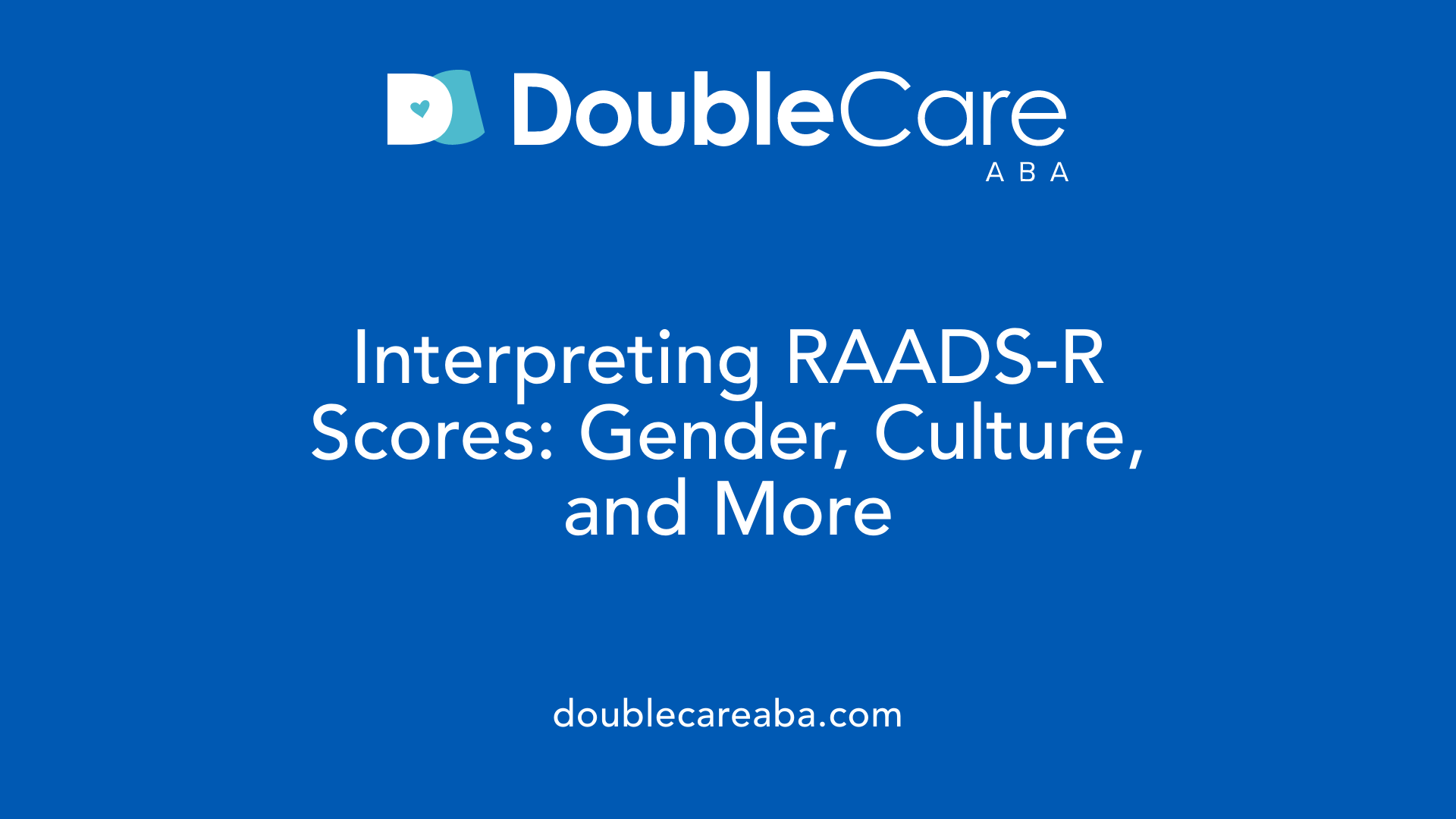
What factors should clinicians consider when interpreting RAADS-R scores?
Interpreting RAADS-R results requires careful consideration of various clinical and demographic factors beyond the raw scores. Gender identity plays a significant role, with research indicating that non-binary individuals tend to score higher on the RAADS-R. This highlights the importance of applying a comprehensive assessment approach that accounts for gender diversity to avoid misinterpretation.
Cultural background is another critical factor influencing responses. Differences in social norms, communication styles, and sensory experiences across cultures can affect how individuals perceive and respond to RAADS-R items. Clinicians should be mindful of these nuances to accurately contextualize test results.
Furthermore, co-occurring conditions such as anxiety, depression, or ADHD can influence behaviors assessed by the RAADS-R, potentially inflating or masking autism-related traits. Masking strategies, where individuals consciously or unconsciously camouflage autistic behaviors to fit social expectations, also complicate score interpretation. Recognizing these adaptive behaviors is essential for understanding the full clinical picture.
Therefore, RAADS-R scores should be integrated with detailed clinical interviews, collateral information, and other standardized assessments. This multidimensional evaluation ensures that factors like gender identity, cultural context, co-existing conditions, and compensatory strategies are accounted for, ultimately leading to accurate identification and support for adults with autism spectrum disorder.
RAADS-R Adoption in Applied Behavior Analysis (ABA) and Clinical Practice
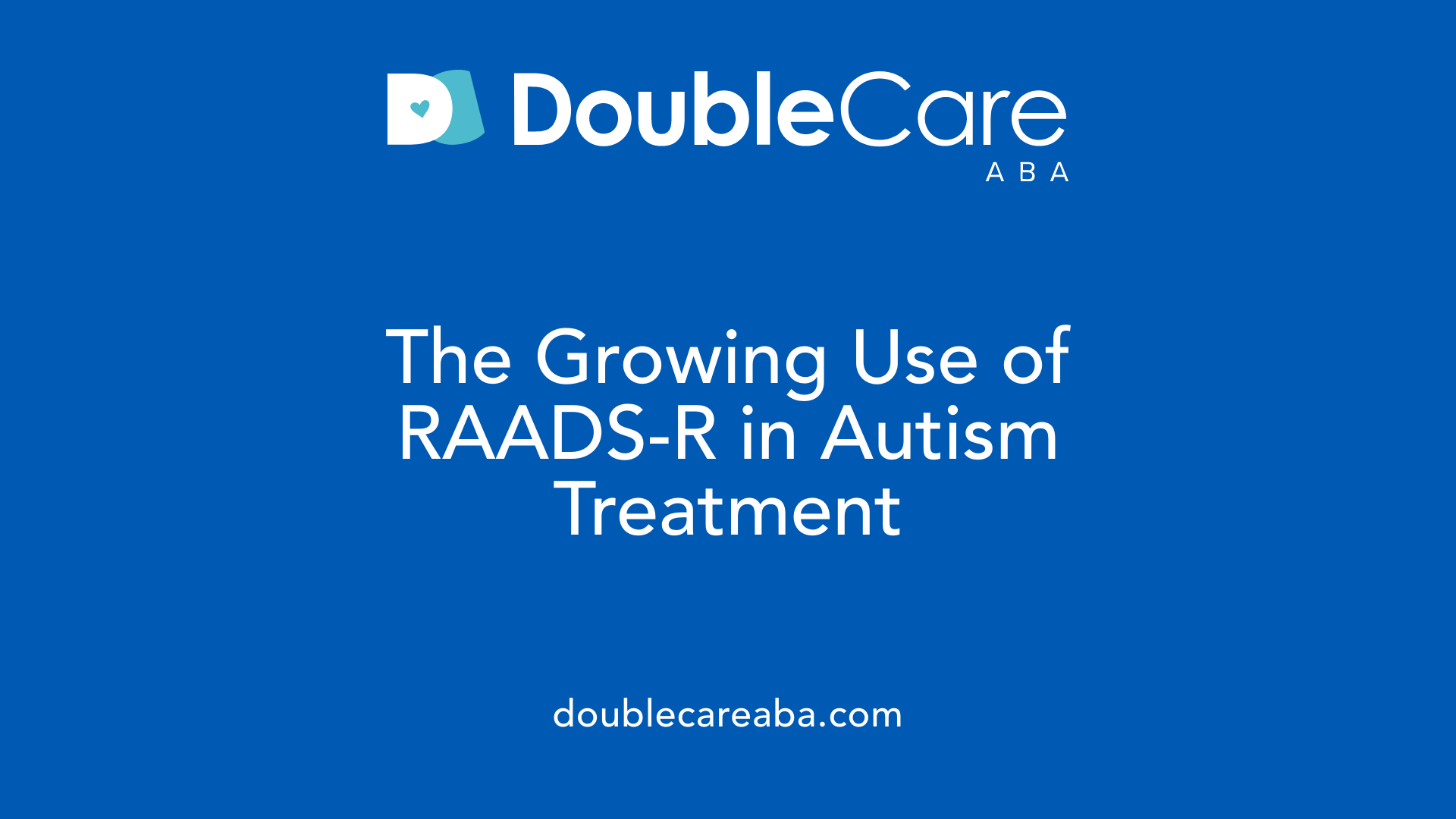
Use of RAADS-R by major ABA agencies and medical professionals worldwide
The RAADS-R has gained widespread acceptance among major Applied Behavior Analysis (ABA) agencies and healthcare professionals globally. Its validated reliability and efficacy make it a trusted tool in identifying autism traits in adults, particularly those with subtle or previously undiagnosed indications. The instrument's design as a clinician-administered, self-report questionnaire allows for efficient screening that complements comprehensive diagnostic practices rather than replacing them. The high sensitivity (97%) and specificity (100%) of the RAADS-R reinforce confidence in its use within diverse clinical settings.
RAADS-R's Contribution to Individualized Behavioral Therapy Planning
Beyond identification, the RAADS-R's detailed assessment of four core symptom domains—language, social relatedness, sensory-motor behaviors, and circumscribed interests—plays a crucial role in shaping personalized behavioral intervention plans. By providing nuanced subscale profiles alongside developmental history, clinicians and behavior analysts gain a richer understanding of an individual's unique autism-related traits. This depth of insight enables the tailoring of ABA therapy strategies that address specific challenges and strengths, improving treatment outcomes. The tool’s ability to highlight persistent patterns versus adult-onset characteristics also informs long-term care planning and goal-setting.
Applied Behavior Analysis: Overview and Connection to Autism Therapy
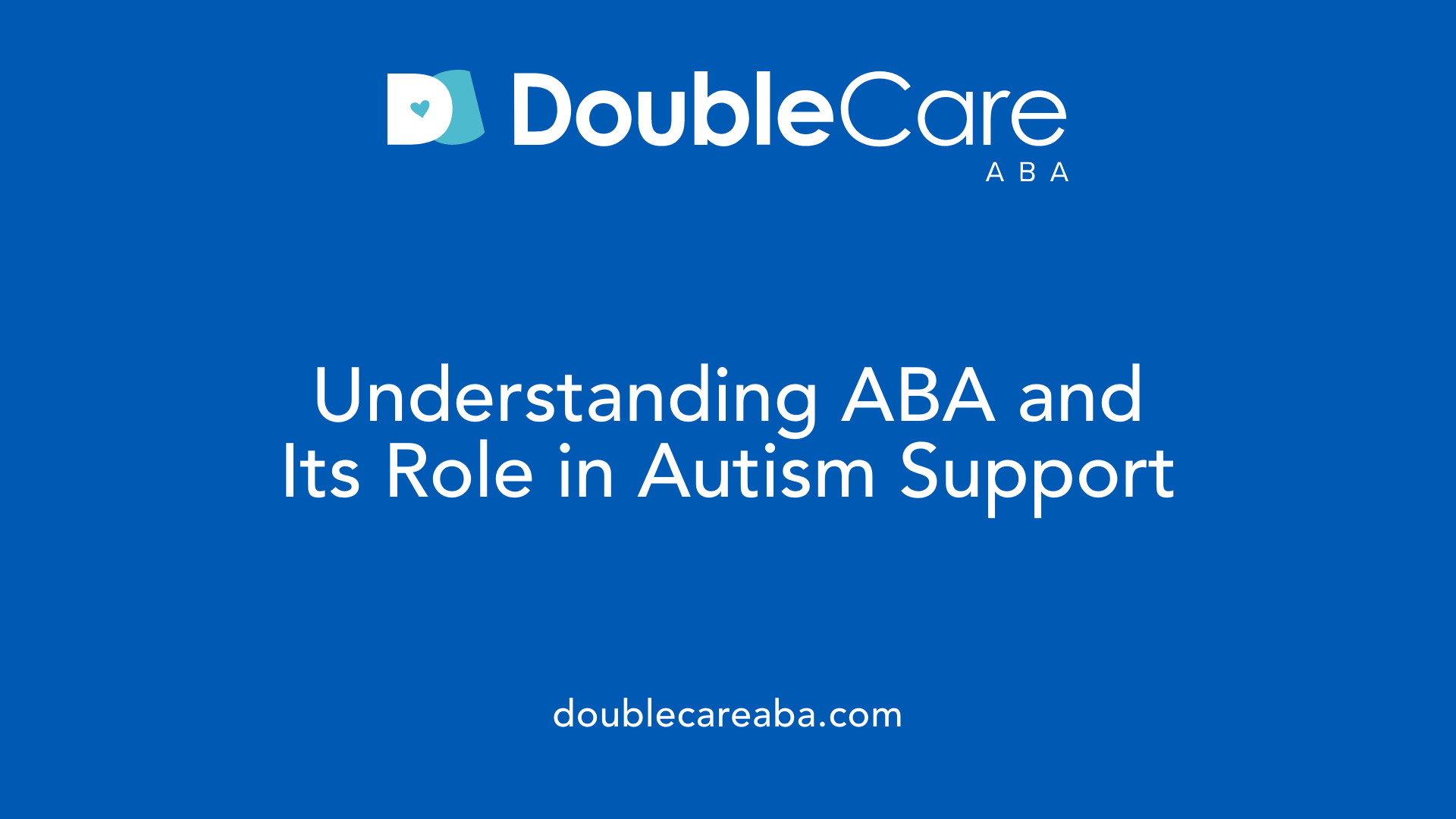
What is applied behavior analysis in autism therapy?
Applied Behavior Analysis (ABA) is a scientifically-based therapeutic approach focusing on understanding and modifying human behavior by analyzing environmental factors. ABA aims to increase helpful behaviors such as communication, social interaction, and daily living skills while reducing harmful or disruptive behaviors.
Definition and goals of ABA therapy in autism
ABA therapy is designed to support individuals on the autism spectrum by breaking down complex skills into manageable steps. It employs tailored intervention strategies to enhance learning and independence that accommodate each person's unique needs.
Key goals of ABA in autism include:
- Improving social communication skills
- Enhancing behavioral flexibility
- Increasing self-care and adaptive behaviors
- Reducing behaviors that impede learning or social integration
Scientific principles and individualized intervention strategies
ABA relies on core behavioral principles such as positive reinforcement (rewarding desired behaviors), prompting (guiding actions), and extinction (eliminating unwanted behaviors). These techniques are selectively applied based on individual assessments to maximize effectiveness.
Intervention strategies are adapted through ongoing monitoring and data collection, ensuring progress is measurable and goals remain relevant. This personalized approach helps address the diverse challenges faced by individuals with autism, making ABA a widely endorsed method in autism therapy globally.
Who Provides ABA Therapy for Autism?

Roles of BCBAs, BCaBAs, and RBTs
Applied Behavior Analysis (ABA) therapy for autism is delivered by a team of licensed and trained professionals. Board Certified Behavior Analysts (BCBAs) lead the design and oversight of individualized behavior plans. Assistant Behavior Analysts (BCaBAs) support BCBAs by assisting in implementing these plans. Registered Behavior Technicians (RBTs) work directly with clients to apply ABA techniques during therapy sessions.
Settings and Method of Delivering ABA Services
ABA therapy can occur in multiple settings such as homes, schools, and community environments. This variety ensures that interventions are contextually relevant and promote learning across daily life activities. The therapy involves data-driven approaches with continuous monitoring of progress to adapt treatment plans effectively.
Access and Ethical Considerations
Ethical standards guide ABA services by ensuring treatments are individualized, respectful, and evidence-based. Providers strive to involve families and caregivers actively, tailoring therapies to each person's unique needs. Access to quality ABA may depend on insurance, referrals, and local resources, highlighting the importance of equitable services for all receiving autism care.
Benefits of Applied Behavior Analysis for Individuals with Autism

How does applied behavior analysis benefit individuals with autism?
Applied Behavior Analysis (ABA) benefits individuals with autism by offering personalized, evidence-based interventions aimed at enhancing essential life skills. These include communication, social interaction, self-care, and academic abilities, all of which are critical for daily functioning and independence.
ABA programs are tailored to the unique needs of each individual, ensuring interventions are relevant and effective. This customization is particularly valuable as it can be implemented flexibly across various settings such as home, school, and community environments.
Another significant advantage of ABA is its focus on reducing problematic behaviors. By understanding the antecedents and consequences of behaviors, ABA strategies help individuals develop more adaptive responses, which leads to improved quality of life.
Extensive research demonstrates that intensive and early ABA therapy can lead to notable improvements in intellectual functioning and social skills among individuals with autism. These gains contribute to increased independence and better integration into society.
Overall, ABA's structured yet adaptable approach supports meaningful development, allowing individuals with autism to reach their potential and lead more fulfilling lives.
How RAADS-R Supports ABA and Broader Autism Interventions
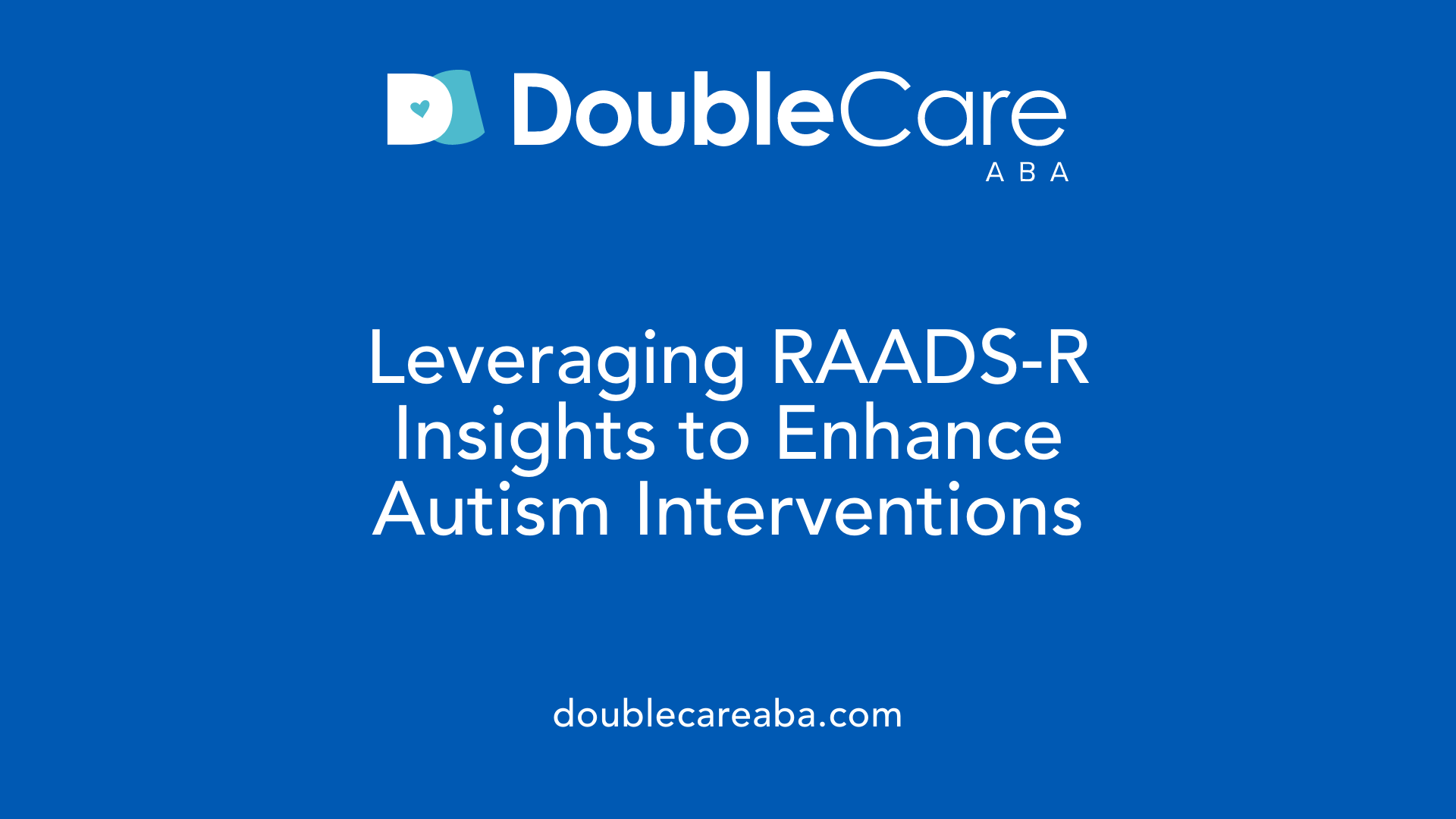
Use of RAADS-R results to inform behavioral intervention planning
The RAADS-R offers detailed insights into an individual's autism-related traits across four domains: language, social relatedness, sensory-motor behaviors, and circumscribed interests. These insights help clinicians and behavior analysts tailor behavioral intervention plans by highlighting specific areas requiring support. For example, elevated scores in sensory-motor difficulties can guide the selection of sensory integration strategies, while challenges in social communication inform social skills training targets. Understanding both current and historical symptoms through the RAADS-R further aids in designing interventions that address lifelong patterns rather than just adult-onset behaviors.
Integration with ABA therapy and other clinical supports
The RAADS-R is widely used by major Applied Behavior Analysis (ABA) agencies and clinical professionals internationally due to its validated reliability and relevance to adult autism assessment. Though not a standalone diagnostic tool, RAADS-R results complement comprehensive clinical evaluations to provide a well-rounded understanding of an individual's profile. This integration supports informed decision-making for intervention prioritization and multidisciplinary collaboration. ABA therapy programs, informed by RAADS-R profiles, can incorporate individualized goals addressing language use, social interactions, focused interests, and sensory needs. Additionally, clinicians consider RAADS-R findings alongside other assessments, clinical interviews, and collateral information to craft holistic support strategies that optimize functioning and quality of life for adults on the autism spectrum.
The Importance of Comprehensive Evaluations Beyond RAADS-R
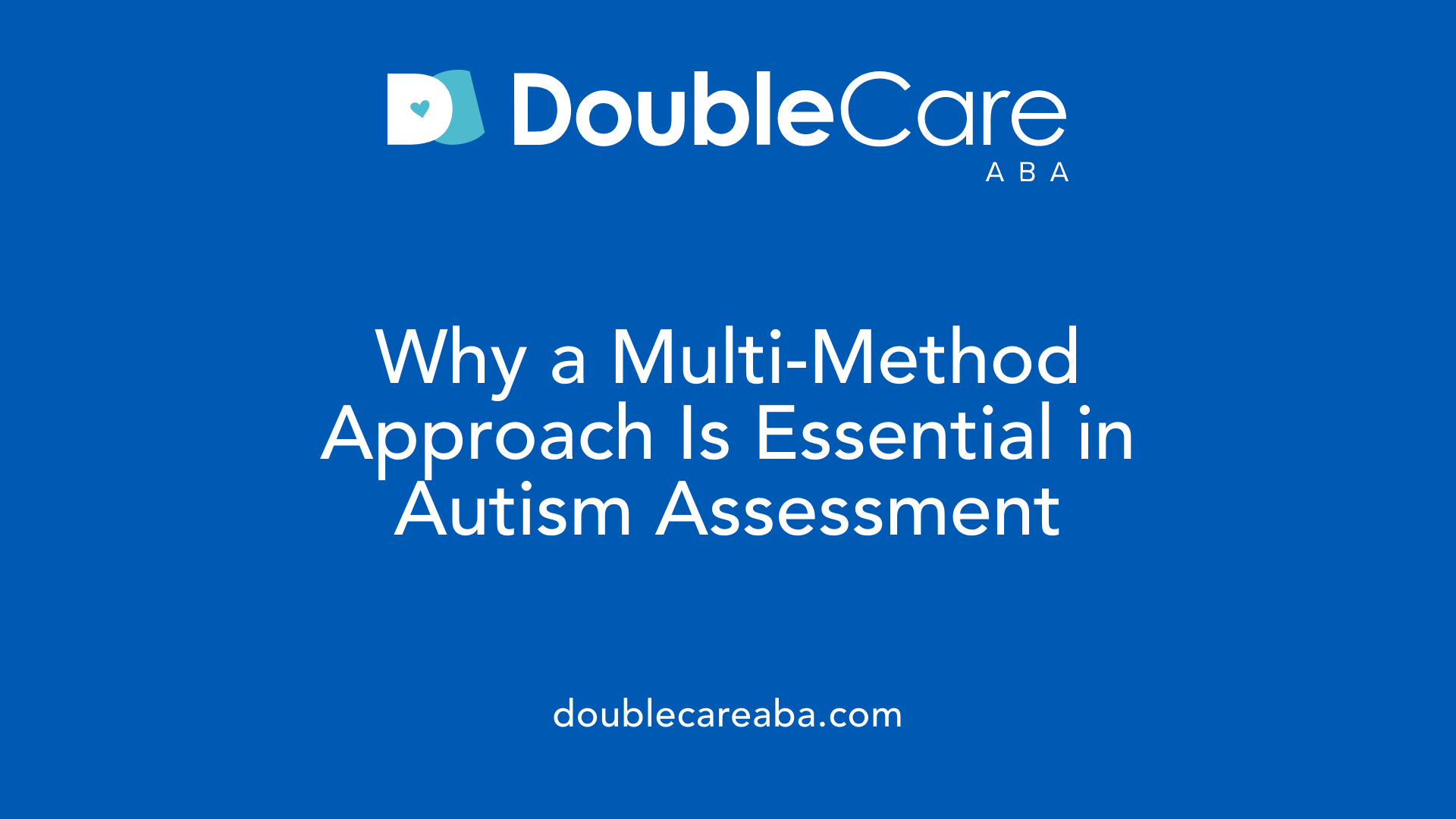
Why is a multi-method assessment essential beyond RAADS-R?
While the RAADS-R offers robust screening through its 80-item self-report structure, capturing four crucial autism domains, it is not designed to be a standalone diagnostic tool. The complexity of autism spectrum disorder (ASD), especially among adults, necessitates a broader diagnostic approach. Comprehensive evaluations incorporate clinical interviews, observational data, and collateral information from family or caregivers, which capture nuanced behaviors and longitudinal context not accessible through self-report alone.
Clinical interviews allow professionals to explore developmental history, current functioning, and symptom expression in depth. Observational data add an objective layer by assessing social communication and repetitive behaviors in real-world or clinical settings. Collateral reports further validate the consistency and pervasiveness of traits across environments, an important factor given that some adults may mask symptoms or experience co-occurring conditions that influence presentation.
How do comprehensive evaluations support differential diagnosis and personalized treatment?
ASD symptoms often overlap with other neurodevelopmental or psychiatric conditions, so differentiating autism from disorders such as ADHD, anxiety, or mood disorders is crucial. Comprehensive assessment strategies help delineate these conditions by integrating multiple data sources, ensuring that diagnoses are not based solely on questionnaire scores, including those from RAADS-R.
Tailored intervention plans arise from this nuanced understanding. Treatments can be individualized based on detailed behavioral profiles, sensory needs, communication styles, and co-occurring challenges identified during thorough assessments. Furthermore, comprehensive evaluations consider variables like gender, cultural background, and masking behaviors, which influence both diagnosis and treatment response.
Thus, while the RAADS-R is a reliable, validated instrument that contributes valuable insights into autism-related traits in adults, it is best utilized as one component within a multi-method evaluation framework. This holistic approach ensures accurate identification, supports clinical decision-making, and ultimately improves outcomes for autistic adults.
Ethical Considerations in Using RAADS-R and ABA Therapy

Can individuals self-diagnose autism using the RAADS-R?
No, individuals cannot self-diagnose autism using the RAADS-R. This 80-item self-report questionnaire is specifically designed as a clinician-administered tool to support the diagnostic process for adults suspected of having autism spectrum disorder (ASD). While the tool provides valuable information on social relatedness, language, sensory-motor issues, and circumscribed interests, professional interpretation is essential to accurately understand scores and patterns.
The RAADS-R as an aid to clinical decision-making, not self-diagnosis
The RAADS-R guides clinical decisions by quantifying autism traits through its total score and subscales. Clinicians use thresholds to help identify individuals who may need further comprehensive evaluations. Scores indicating "consistent with autism" or "pronounced traits" prompt further assessment rather than serve as standalone diagnoses. This cautious use respects the complexity of ASD and avoids misinterpretation that could arise from layperson use.
Importance of ethical, evidence-based practice in autism therapy
Ethical practice in autism diagnosis and treatment demands evidence-based tools like the RAADS-R be integrated alongside clinical interviews and other standardized assessments. Applied Behavior Analysis (ABA) therapy and other interventions should follow thorough, professional evaluations to ensure the best outcomes. Ethical considerations emphasize respecting individual differences, avoiding over-diagnosis, and tailoring interventions to each adult’s unique needs. Incorporating the RAADS-R responsibly helps maintain these standards, promoting accurate diagnoses and appropriate therapy plans.
The RAADS-R: A Vital Component in Adult Autism Care
The RAADS-R test stands as a validated, reliable, and valuable instrument for identifying autism spectrum disorder traits in adults, particularly those who have flown under the diagnostic radar in earlier life stages. Its comprehensive coverage of key symptom domains, combined with updated scoring thresholds and clinical considerations, makes it an important tool that complements broader diagnostic and therapeutic efforts. When integrated with evidence-based approaches like Applied Behavior Analysis, it supports tailored intervention planning that can significantly improve life outcomes. As the understanding of adult autism continues to evolve, the RAADS-R remains central in bridging the gap between recognition and effective, individualized care.
References
- RAADS-R Test - Ritvo Autism Asperger Diagnostic Scale ...
- RAADS-R Test: Understanding the Test for Better Results
- A Therapist's Guide to the Ritvo Autism Asperger ...
- Applied Behavior Analysis (ABA)
- Applied Behavior Analysis (ABA)
- 6 Benefits of ABA Therapy for Children with Autism
- Applied Behavior Analysis (ABA)
- What Services Are Available for Children with Autism in ...














